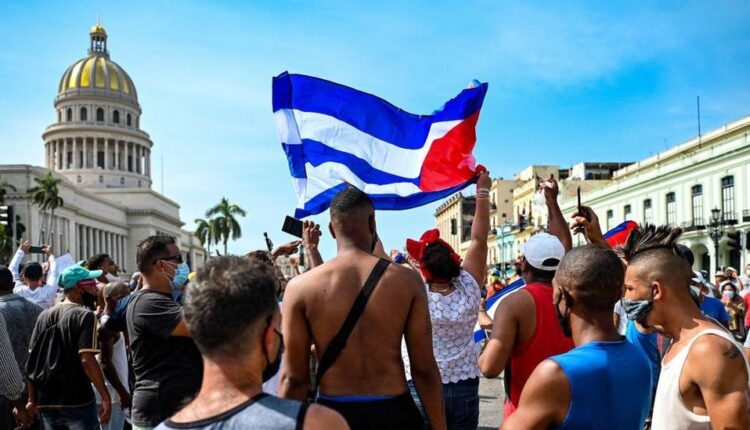
Cuba one year after the protests
ne year ago, on July 11, a small protest by Cuban dissidents in a poor suburb of Havana sparked nationwide anti-government demonstrations. In dozens of cities and towns, thousands marched to protest shortages of food and medicine, electricity blackouts, and a surge in Covid-19 infections. Most of the demonstrations were peaceful, but in some neighborhoods, protesters battled with police, overturned cars, and looted stores.
The unprecedented protests were a symptom of deep economic and political discontent.They shocked Cuba’s leaders, emboldened the opposition, and rekindled Washington’s perennial pipe dream of regime change. Twelve months later, Cubans are still struggling with a sputtering economy, which is triggering a surge in irregular migration.
When the protests erupted, President Miguel Díaz-Canel denounced them as counterrevolutionary and called loyalists into the streets to defend the revolution. Police arrested more than 1,300 people. A few days later, however, Díaz-Canel softened his tone, conceding that the demonstrators had legitimate grievances. Subsequent state policy has included both a crackdown on vocal opponents and programs to mitigate the hardships that brought people into the streets. Demonstrators charged with violent crimes have gotten heavy prison sentences, ranging from five to 30 years, and leading dissidents have faced increased harassment or jail. Meanwhile, the government has begun a program to improve living conditions in 302 “vulnerable communities”—poor neighborhoods that were sites of the worst violence on July 11.
Hoping to capitalize on popular discontent, last September a group of opposition artists and intellectuals calling themselves Archipiélago joined traditional dissidents to call for a “Civic March for Change” on November 15. The government denounced them as counterrevolutionary agents of Washington’s regime change strategy. The prospective demonstration garnered enormous international attention and the Biden administration’s full-throated support. But on November 15, no one showed up to march or bang empty pots as the organizers had urged.
The march’s failure was due in part to the government’s harassment and vilification of the organizers. But the demands for political reform, delivered by young, middle-class professionals, did not speak to the most urgent issue for the majority of Cubans: their deteriorating standard of living. The failure of the November protest left the organized opposition demoralized and in disarray. Many of the young artists involved went into exile.
The Biden administration had been inching toward lifting some of Donald Trump’s sanctions on humanitarian grounds, but the scale of the protests revived hopes for regime change, so the sanctions were left in place. “After July 11, we hit the pause button,” explained Juan Gonzalez, Joe Biden’s senior national security director for the Western Hemisphere. Biden’s Cuba policy might have remained on pause indefinitely if the White House had not been pushed into action by a surge of Cuban migrants at the US southern border and the prospect of embarrassment at the Summit of the Americas.
From October 2021 through May 2022, more than 140,000 Cubans arrived at the border—over three times as many as in the entire previous year, and more than had arrived during the 1980 Mariel boat lift or the 1994 rafter crisis. The humanitarian case for sanctions relief was reinforced by the argument that relieving economic pressure on Cuba might reduce the migration surge.
Meanwhile, several Latin American presidents, foremost among them Mexico’s Andrés Manuel López Obrador, threatened to boycott the June summit in Los Angeles over Biden’s decision to exclude Cuba, Venezuela, and Nicaragua. The White House tried to mollify the Latin American left by relaxing some of the sanctions on Cuba, but López Obrador and half a dozen other heads of state stayed home anyway.
Biden’s measures were good in theory but weak in practice. Limits on remittances were eliminated, but there is no provision enabling Western Union to resume remittance wire services. People-to-people group travel was restored, but the ban on using government-owned hotels makes large group tours nearly impossible. The Cuban Family Reunification Program resumed, potentially enabling safe, legal immigration, but most Cubans must still travel to a third country to request a visa. Without further action, Biden’s tentative steps forward will have limited effect.
Cuba is facing another long, hot summer of shortages and electrical blackouts. Inflation has leveled off, but with the informal exchange rate of the Cuban peso to the US dollar at four times the official one, real incomes have stagnated. Although the tourism industry has reopened, the number of foreign visitors in the first quarter of this year was down 77 percent from 2019. Cuba is also suffering collateral damage from the war in Ukraine as global inflation pushes up the prices of food and fuel, Cuba’s main imports.
The current economic crisis is the principal driver of the migration surge, but Cubans are also exhausted from years of unrelenting hardship. The people leaving are disproportionately young adults who see a bleak future for themselves on the island. Eleven years after Raúl Castro announced his plans to build a “prosperous and sustainable” socialism, the reforms are still incomplete, the economy is no more prosperous, and living standards have not improved. Díaz-Canel’s slogan, “We are continuity,” meant to convey stability in the post-Castro era, rings hollow, especially to younger generations impatient for change.
From The Nation.


